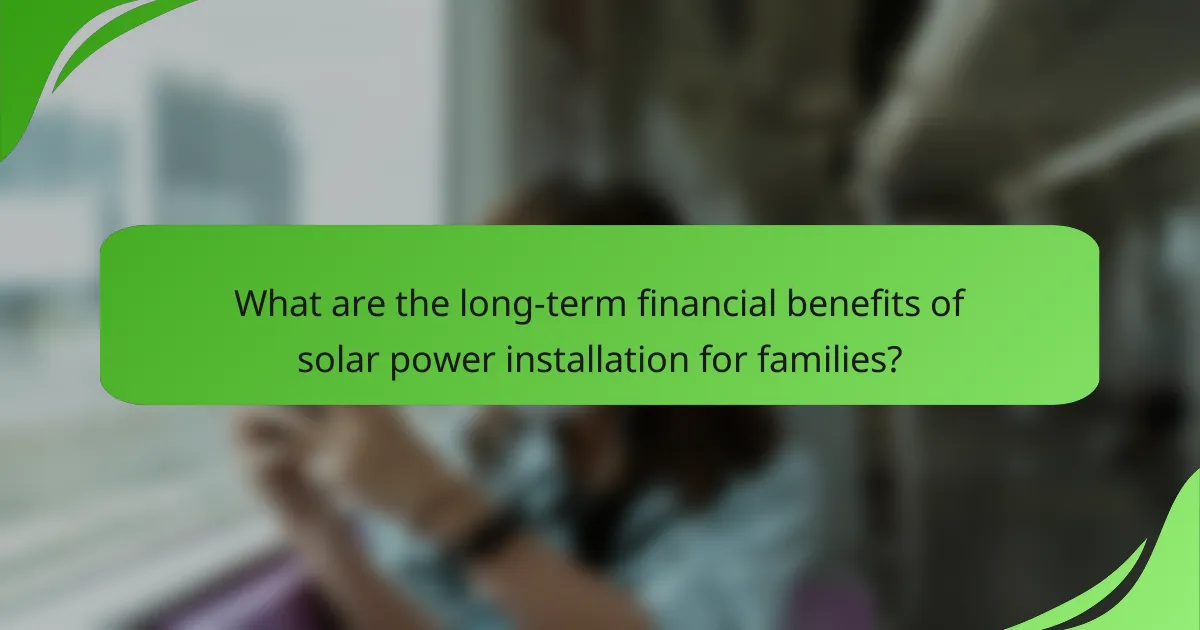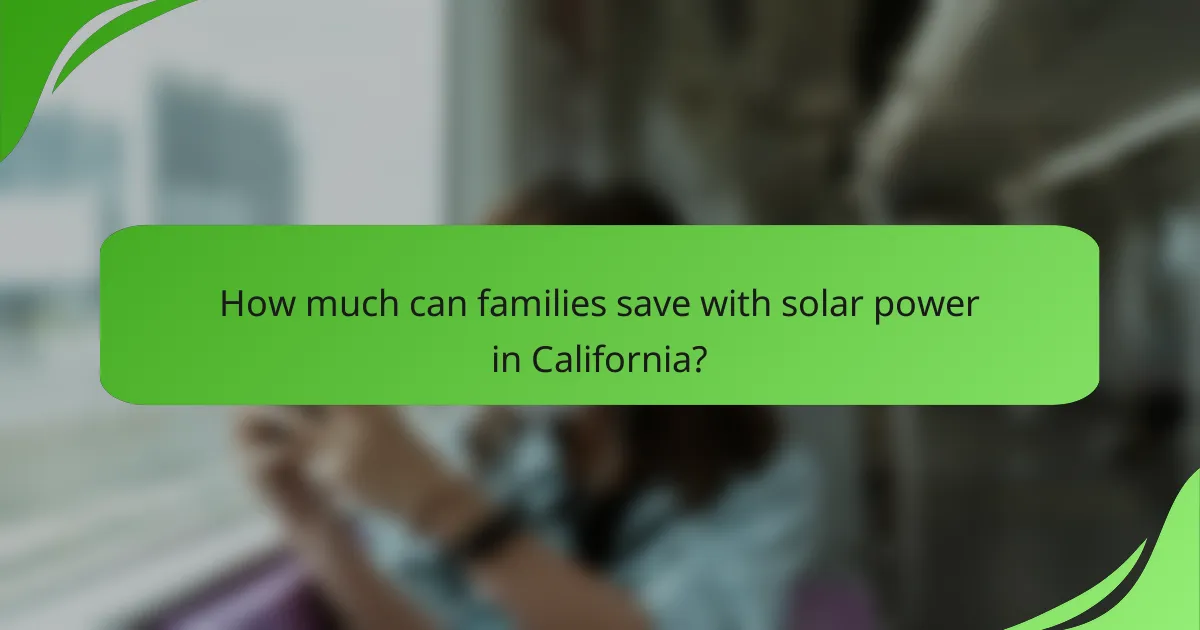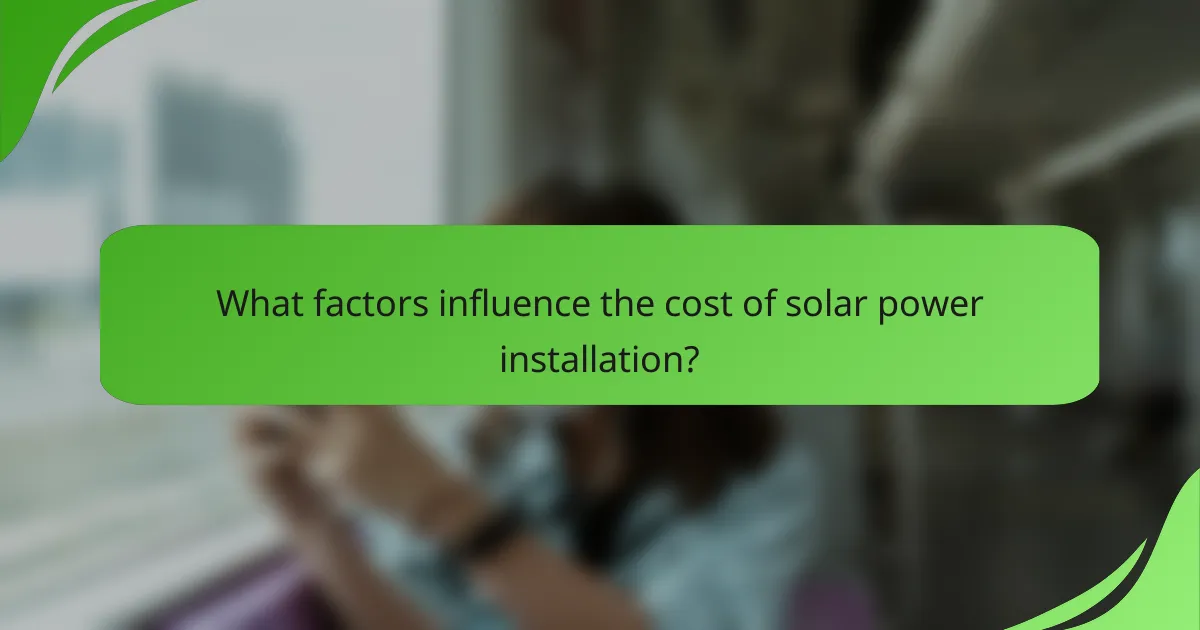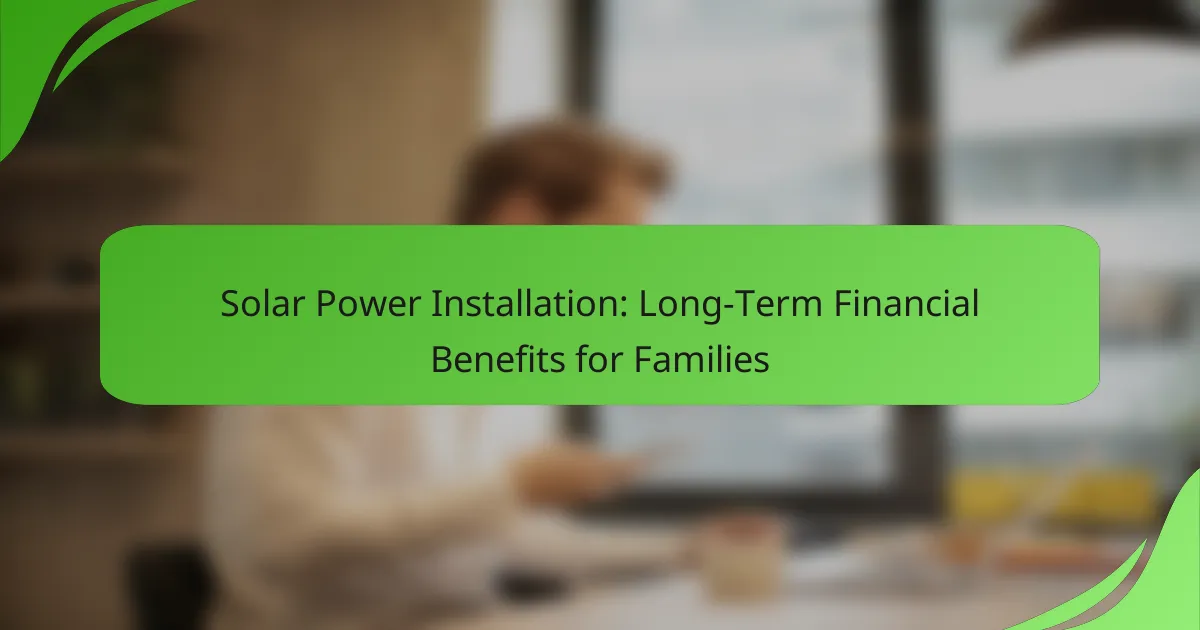Installing solar power systems offers families substantial long-term financial benefits, including reduced electricity bills and increased property value. By leveraging available tax incentives and understanding the factors that influence installation costs, households can achieve significant savings and enhance their financial stability over time.

What are the long-term financial benefits of solar power installation for families?
Families can enjoy significant long-term financial benefits from solar power installation, primarily through savings on electricity bills, increased property value, and available tax incentives. These advantages contribute to lower overall energy costs and enhance the financial stability of households over time.
Reduced electricity bills
One of the most immediate financial benefits of solar power installation is the reduction in electricity bills. By generating their own electricity, families can significantly lower or even eliminate their monthly utility costs. Depending on the size of the system and local energy prices, savings can range from 20% to 50% or more.
Moreover, many regions offer net metering programs, allowing homeowners to sell excess energy back to the grid. This can further offset costs and enhance savings, making solar power a financially savvy choice for many families.
Increased home value
Installing solar panels can increase a home’s market value. Studies have shown that homes with solar energy systems sell for a premium compared to those without. On average, solar installations can add tens of thousands of dollars to a property’s value, depending on the system size and local market conditions.
Potential buyers often view solar panels as a desirable feature, especially in areas with high electricity rates. This increased demand can lead to quicker sales and higher offers when it comes time to sell.
Tax incentives and rebates
Families can take advantage of various tax incentives and rebates when installing solar power systems. In the United States, the federal solar tax credit allows homeowners to deduct a significant percentage of the installation costs from their federal taxes. Many states and local governments also offer additional rebates and incentives, which can reduce upfront costs substantially.
It’s essential to research available incentives in your area, as they can vary widely. Consulting with a local solar provider can help families navigate these options and maximize their financial benefits.
Low maintenance costs
Solar power systems generally require minimal maintenance, which translates to lower long-term costs for families. Most solar panels come with warranties lasting 20-25 years, and routine maintenance typically involves simple cleaning and occasional inspections.
Unlike traditional energy sources, solar energy systems do not have moving parts that can wear out quickly. This reliability means families can enjoy long-term savings without worrying about frequent repairs or replacements.
Energy independence
Solar power installation provides families with a degree of energy independence, reducing reliance on utility companies and fluctuating energy prices. By generating their own electricity, families can shield themselves from rising energy costs and potential supply disruptions.
This independence can be particularly valuable during power outages or in areas prone to energy instability. Families can enjoy peace of mind knowing they have a sustainable energy source that can help them weather financial uncertainties related to energy expenses.

How much can families save with solar power in California?
Families in California can save significantly on their energy bills by installing solar power systems, with average savings ranging from hundreds to thousands of dollars annually. The exact amount depends on factors like system size, energy consumption, and local electricity rates.
Average savings per year
On average, California families can save between $1,000 and $2,500 each year on electricity costs after installing solar panels. These savings can vary based on the size of the solar system and the household’s energy usage patterns. Additionally, savings may increase over time as utility rates rise.
Impact of net metering
Net metering allows solar panel owners to receive credits for excess energy generated and sent back to the grid. In California, this means families can offset their energy costs by using these credits during periods of low solar production, such as at night. This system enhances overall savings and makes solar power even more financially attractive.
Long-term ROI estimates
The return on investment (ROI) for solar power installations in California typically ranges from 10% to 20% over a 20 to 25-year period. Factors influencing ROI include initial installation costs, available incentives, and energy savings. Families should consider these elements when evaluating the long-term financial benefits of solar energy.

What factors influence the cost of solar power installation?
The cost of solar power installation is influenced by several key factors, including system size, type of solar panels, and installation complexity. Understanding these elements can help families make informed decisions about their solar investments.
System size and capacity
The size of the solar power system directly affects the overall installation cost. Larger systems, measured in kilowatts (kW), typically have higher upfront costs but can generate more electricity, potentially leading to greater long-term savings.
When considering system size, families should evaluate their energy consumption patterns. A system that meets or slightly exceeds energy needs can maximize savings while minimizing excess energy production.
Type of solar panels
The type of solar panels chosen can significantly impact installation costs. There are generally three types: monocrystalline, polycrystalline, and thin-film, with monocrystalline panels often being the most efficient and expensive.
Families should consider the trade-offs between efficiency and cost. While monocrystalline panels may have a higher initial investment, their efficiency can lead to lower overall costs in the long run, especially in limited space scenarios.
Installation complexity
The complexity of the installation process can also influence costs. Factors such as roof type, angle, and accessibility can affect labor costs and the overall installation timeline.
To minimize expenses, families should seek quotes from multiple installers and ask about their experience with similar installations. Understanding the specifics of your roof and site can help avoid unexpected costs during the installation process.

What financing options are available for solar power installation?
Families looking to install solar power systems have several financing options to consider, each with its advantages and drawbacks. The most common methods include solar loans, leasing options, and power purchase agreements (PPAs), which can help make solar energy more accessible and affordable.
Solar loans
Solar loans allow homeowners to borrow money to purchase a solar power system, which they then pay back over time, typically with interest. These loans can be secured or unsecured, with terms usually ranging from five to twenty years. Many financial institutions offer specific solar loan products that may have lower interest rates compared to traditional loans.
When considering a solar loan, evaluate your credit score, as it can significantly impact the interest rate you receive. Additionally, check for any available government incentives or rebates that can reduce the overall cost of the system, making the loan more manageable.
Leasing options
Leasing options allow families to use a solar power system without the upfront costs of purchasing it. In a lease agreement, the homeowner pays a fixed monthly fee to use the solar panels, while the leasing company retains ownership. This option can be appealing for those who prefer predictable expenses and do not want to deal with maintenance responsibilities.
However, leasing may limit the financial benefits associated with tax credits and incentives that are typically available to system owners. Families should carefully review the lease terms and consider how long they plan to stay in their home, as moving before the lease ends can complicate matters.
Power purchase agreements (PPAs)
Power purchase agreements (PPAs) are similar to leases, but instead of paying a fixed monthly fee, homeowners pay for the electricity generated by the solar panels at a predetermined rate. This can often be lower than the local utility rate, providing immediate savings on energy bills. The solar provider owns and maintains the system, relieving the homeowner of those responsibilities.
PPAs can be a great option for families who want to benefit from solar energy without the upfront costs. However, it’s essential to understand the terms of the agreement, including the length of the contract and what happens if you sell your home before it expires. Always compare the PPA rates with local utility rates to ensure you are getting a good deal.

How do solar power installations affect home insurance?
Solar power installations can influence home insurance by potentially increasing premiums and requiring specific coverage for solar equipment. Homeowners should understand these impacts to make informed decisions about their insurance policies.
Potential increases in premiums
Installing solar panels may lead to increased home insurance premiums. Insurers often view solar systems as valuable additions that can raise the home’s overall worth, which may result in higher coverage costs.
Premium increases can vary widely based on the insurer and the specific installation. Homeowners might see increases in the low tens of dollars per year, but it is essential to shop around and compare quotes from different providers to find the best rate.
Coverage for solar equipment
Homeowners should ensure their insurance policy includes coverage for solar equipment. Standard homeowners insurance may not automatically cover damage to solar panels or related components, so it’s crucial to verify this with your insurer.
Consider adding a rider or endorsement to your policy specifically for solar equipment. This additional coverage can protect against risks such as theft, vandalism, or damage from severe weather, ensuring that your investment is adequately safeguarded.

What are the environmental benefits of solar power for families?
Solar power offers significant environmental benefits for families by reducing reliance on fossil fuels and decreasing greenhouse gas emissions. By harnessing sunlight, families can contribute to cleaner air and a more sustainable future.
Reduction in Carbon Footprint
Switching to solar energy can greatly reduce a family’s carbon footprint. Traditional energy sources like coal and natural gas release large amounts of carbon dioxide when burned. In contrast, solar panels generate electricity without emissions, helping to combat climate change.
For families, this means that by installing solar panels, they can significantly lower their contribution to global warming. A typical residential solar system can offset several tons of carbon dioxide each year, depending on energy usage and system size.
Conservation of Water Resources
Solar power systems use minimal water compared to conventional energy sources, which often require significant water for cooling and processing. This conservation is vital in areas facing water scarcity.
Families can feel good knowing that by choosing solar, they are helping to preserve local water supplies. For instance, solar energy systems typically use less than 1% of the water needed for coal or natural gas plants, making it a more sustainable choice.
Promotion of Biodiversity
By reducing the need for fossil fuel extraction and the associated habitat destruction, solar power helps protect local ecosystems and biodiversity. Families opting for solar energy contribute to preserving wildlife habitats that might otherwise be threatened by mining or drilling activities.
Additionally, solar farms can be designed to coexist with agricultural practices, allowing for dual land use that supports both energy production and farming, further promoting biodiversity.
